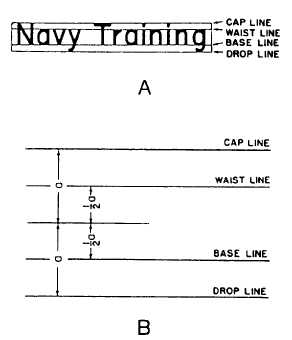Figure 3-42.-Laying off guidelines.
character i in figure 3-42, view A. All ascenders
are as high as the caps.
The drop line indicates the lower limit of the
lowercase letters. The descender is the part of the
lowercase letter that extends below the body of
the letter, an example being the tail of the
character g in figure 3-42, view A. The vertical
distance from the drop line to the base line is the
same as the vertical distance from the waist line
to the cap line. It is about one third of the
vertical distance between the base line and the cap
line, or about one half of the vertical distance
between the base line and the waist line.
Figure 3-42, view B, shows an easy way to
lay out guidelines for caps and lowercase.
Let the height of a capital be 1 1/2 times the
distance “a.” Set a compass or dividers to
distance “a,” and lay off distance “a” above and
below the midline selected for the guidelines, The
method locates the cap line and the drop line.
Then set the compass or dividers to one half
of ’’a,” and lay off this distance above and below
the midline. This method locates the waist line and
the base line.
To help you keep your lettering vertical, it is
a good idea to construct vertical guidelines, spaced
at random along the horizontal guidelines. For
inclined lettering, lay off lines inclined at the
angle you wish your lettering to be slanted. (See
fig. 3-43, view A.) Inclined lines are known as
29.275
Figure 3-43.-Laying off lines for lettering.
direction lines and are normally slanted at a
maximum of 68 degrees.
Ames Lettering Instrument
If you have many lines of lettering to do, you
will find a lettering instrument, such as the Ames
lettering instrument, shown in figure 3-43, view
B, quite useful and timesaving. The top-left
section of figure 3-43, view B, shows how to use
this instrument in conjunction with a T square to
draw properly spaced horizontal guidelines. You
insert the point of your pencil through one of the
holes, and the instrument slides along the T square
as you move the pencil across the page. The
enlarged drawing of the instrument in the lower
part of the figure shows the details of how the
instrument is used. Notice the three rows of holes
in the circular disc of the instrument. The holes
3-29




